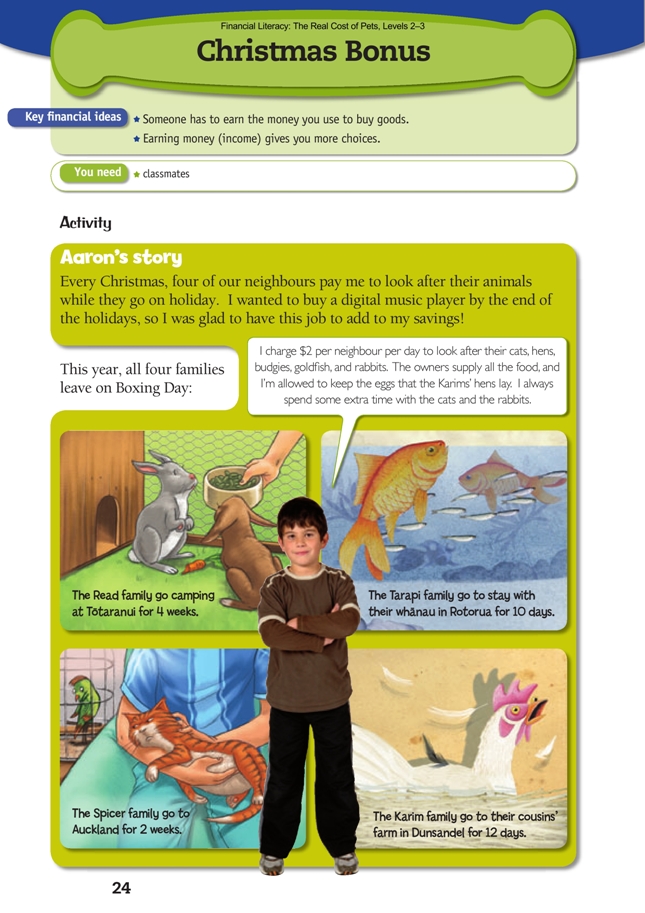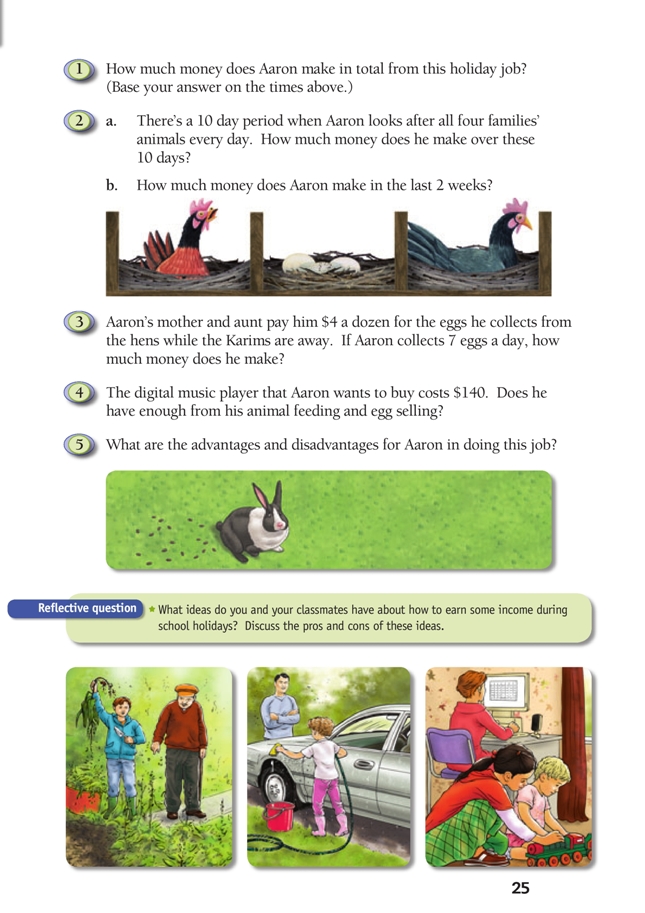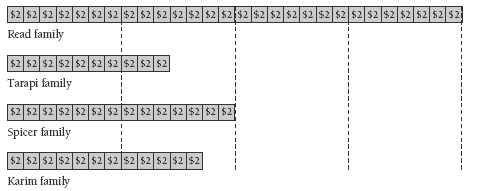This is a level 3 number and algebra activity and a level 2 statistics activity from the Figure It Out series. It relates to Stage 6 of the Number Framework.
A PDF of the student activity is included.
Click on the image to enlarge it. Click again to close. Download PDF (1739 KB)
use times tables to calculate income
use mental strategies to calculate income totals
Number Framework Links
Students at stage 5 and stage 6 should be able to use numeracy strategies to solve the problems. (See the table of NDP material on page 4.)
FIO, Levels 2-3, Financial Literacy: The Real Cost of Pets, Christmas Bonus, pages 24-25
Classmates
Financial understanding
In this activity, Aaron uses his holiday time to earn money to meet his goal of buying a digital music player. In this case, he is financially successful in meeting his goal, but it is worth discussing with your students that personal goals sometimes contribute to financial problems (for example, if a person doesn’t realise that their personal goal is unattainable at a particular point in time).
Aaron matches personal goals and capabilities to an undertaking when he looks after his neighbours’ animals over the holiday period. By doing this, he demonstrates the first steps of taking responsibility for managing himself.
You could introduce this activity by brainstorming where your students go on holiday, how long they are away for, and what they do with their pets while they are away. You could discuss with those who don’t go away what they do with their time, and if they earn money during this period, how and for what purpose.
Mathematics and statistics
For this activity, the students need to know the number of days in a week and how many eggs in a dozen.
Students who are at stages 2–3 may find acting out the problem makes the mathematics clearer. Students at stage 4 could probably solve the mathematical problems with your guidance (including using the visual representation suggested over the page), or they may be able to solve them independently using a calculator.
This visual representation of the problem in questions 2a and 2b may clarify when each family is away:
Ask: What is 10 lots of 2? How much does it cost for each family for 10 days? How many families are there? What do you need to do now to work out how much money Aaron makes over the 10 days when all the families are away?
The students will use various ways to solve question 3. Discuss their strategies as a class and encourage the students to look for the most efficient strategies to solve problems like this. The students may require some scaffolding to be able to visualise how others solved the problem. This may include modelling, using symbols
on the board or materials like a modified tens frame or egg carton, an array (12 x 7 or 10 x 7 + 2 x 7), or a happy hundreds board to demonstrate the multiplicative properties.
Discussion topics
• How would your holidays be different if you were earning money or working as a volunteer? Is it better to spend your holidays working to earn money or as an unpaid volunteer or is it better to have time to yourself?
• How else could you earn money during the holidays? (For example, students interested in animals might go to a nearby cattery or kennels to help during the business’s busy periods.)
• How else could you care for your neighbours’ properties over the holidays? (For example, going in and opening windows, putting out washing to make it appear that there’s someone home to reduce the possibility of burglary, clearing letterboxes of mail and junk mail, mowing lawns, turning lights on and off [with parent help, as it would be night-time])
Social Sciences Links
Achievement objectives:
• Understand how people have social, cultural, and economic roles, rights, and responsibilities (Social Studies, level 2)
The students could discuss what Aaron’s roles, rights, and responsibilities are as an animal minder. The students could research projects like Neighbourhood Watch, why it is there, what purpose it serves.
• Understand how people make choices to meet their needs and wants (Social Studies, level 2)
The students could discuss what choices Aaron is making to fulfil his wants.
Other Cross-curricular Links
Health and Physical Education achievement objective:
• Safety management: Identify risks and their causes and describe safe practices to manage these (Personal Health and Physical Development, level 3)
The students could look at health and safety concerns about looking after other people’s pets. For example, if the neighbour’s dog is not always friendly to a child, how can they keep themselves safe when feeding it? Should they accept that particular job?
Answer to Activity
1. a. $205.20 ($90 + $53 + $2.20 + $24 + $36) plus hidden costs such as power, phone, other running expenses
b. $135.20. ($205.20 – $70)
2. Approximately $305.20. ($100 + $90 + $53 + $2.20 + $36 + $24)
3. Answers will vary. For example: a. It will cost Courtney less than buying a cat
from a pet shop and then going to a vet for desexing; vaccinations and other treatment have already been done.
b. They want to find good homes for as many animals as possible, so they try to make it affordable.
c. Hidden costs would include power, phone, heating, equipment, cages, any wages,
transport cost if picking up animals, advertising, and treatment costs for sick
animals.
d. Answers will vary. They might apply for grants from businesses, receive donations,
or do fund-raising.
Reflective question
Answers will vary. It means they don’t have to keep spending money on that animal for food and housing and they get some of the money back that they have spent. They’ll be pleased to have found a good home for one of their animals.


